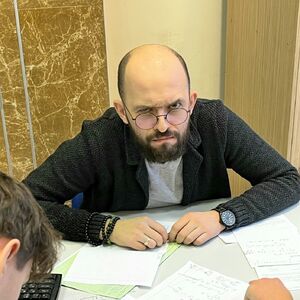Анализ специфичности расщепления ДНК ультразвуком (1102352), страница 14
Текст из файла (страница 14)
Характер изменения частоты расщепления фосфодиэфирных связей от их положенияв цепи фрагмента, а также специфика зависимости общего уровня расщепления ДНК отфизико-химическихпараметровоблучаемогорастворасвидетельствуютомеханохимической природе наблюдаемых разрывов в фрагментах ДНК под действиемультразвука.3. Развит подход к моделированию расщепления фрагментов ДНК под действиемкавитационных эффектов в облучаемом растворе, на основе которого показано, чтовозникающие вблизи кавитационных пузырьков высокие градиенты скорости теченияжидкости (порядка 108 с-1) способны приводить к разрыву фрагментов ДНК длиной внесколько сотен нуклеотидных пар.4. Предложена модель, качественно описывающая явление контекстной специфичностирасщепления ДНКультразвуком.
В соответствии с разработанной моделью,наблюдаемое увеличение частоты расщепления фосфодиэфирной связи, примыкающейкдезоксицитидину,связаносособенностьюконформационнойдинамикидизоксирибозы этого нуклеотида.5. При помощи полученных статистических даных по ультразвуковому расщеплениюДНК показано, что в промоторных областях генов MYC- кластера человека, имеетместо тенденция к уменьшению ультразвукового расщепления по сравнению скодирующими областями.84ЛитератураAbeel T., Saeys Y., Bonnet E., Rouzé P., Van de Peer Y.
Generic eukaryotic core promoterprediction using structural features of DNA // Genome Research. 2008. Vol. 18. P. 310-23.Arora M., Ohl C.D., Lohse D. Effect of nuclei concentration on cavitation cluster dynamics. // JAcoust Soc Am. 2007. V.121(6). P.3432-6.Ashkin A., Dziedzic J.M., Bjorkholm J.E., Chu S. Observation of a single-beam gradient forceoptical trap for dielectric particles. // Optics Lett. 1986.
V.11.P. 288-290.Bajic V.B., Tan S.L., Suzuki Y., Sugano S., Tan S.L., Suzuki Y., Sugano S., Suzuki Y., Sugano S.,Sugano S. Promoter prediction analysis on the whole human genome // Nat. Biotechnol.2004. V. 22. P.1467–1473.Basedow A. M. and Ebert. E.B. Ultrasonic degradation of polymers in solution. // Advances inPolymers Science. A. Abe, A.-C. Albertsson, ., J. Genzer, editors. Springer,Berlin/Heidelberg. 1977. V.22. P. 83–148.Becker N.B., Wolff L., Everaers R. Indirect readout: detection of optimized subsequences andcalculation of relative binding affinities using different DNA elastic potentials // NucleicAcids Res.
2006. Vol. 34. P. 5638-5649.Bensimon D., Simon A.J., Croquette V., Bensimon A. Stretching DNA with a receding meniscus:experiments and models. Phys Rev Lett. 1995. V.74. P. 4754-4757.Binnig G, Quate CG, Gerber C. Atomic force microscope. // Phys Rev Lett. 1986. V. 56. P.930933.Brennen C.E. Cavitation and bubble dynamics. // Oxford University Press.1995.Brukner I., Jurukovski V., Savic A. Sequence-dependent structural variations of DNA revealed byDNase I.// Nucleic Acids Research. 1990.V.
18(4). P. 891–894.Brukner I., Sánchez R., Suck D., Pongor S. Sequence-dependent DNA bending as revealed byDNase I : Bending Parameters for trinucleotides.// EMBO Journal.1995.V. 14. P. 18121818.Bustamante C., Marko J.F., Siggia E.D., Smith S. Entropic elasticity of ambda-phage DNA. //Science. 1994. V. 265. P. 1599-1601.Cao XQ, Zeng J, Yan H. Structural property of regulatory elements in human promoters // PhysRev E Stat Nonlin Soft Matter Phys. 2008.
Vol. 77(4 Pt 1). P. 041908.Cluzel P, Lebrun A, Heller C, Lavery R, Viovy J-L, Chatenay D, Caron F. DNA: an extensiblemolecule.// Science.1996. V. 271. P.792-794.Cordier C., Marcourt L., Dodin G. Conformational variation of the central CG site ind(ATGACGTCAT)2 and d(GAAAACGTTTTC)2.
An NMR, molecular modelling and 3Dhomology investigation. // Eur. J. Biochem. 1999.V. 261.P. 722–733.Das R., Laederach A., Altman R.B. SAFA: semi-automated footprinting analysis software forhigh-throughput quantification of nucleic acid footprinting experiments. RNA.
2005.V.11.P.344–354.Dineen D.G., Wilm A., Cunningham P., Higgins D.G. High DNA melting temperature predictstranscription start site location in human and mouse // Nucleic Acids Res. 2009. Vol.37(22). P.7360-7.Doi M. and Edwards S.F. The Theory of Polymer Dynamics // Clarendon Press,Oxford. 1986.Duchardt E., Nilsson L. and Schleucher J.
Cytosine ribose flexibility in DNA: a combined NMR13C spin relaxation and molecular dynamics simulation study.// Nucleic Acids Res. 2008.V. 36. P. 4211–4219.Faiger H., Ivanchenko M., Cohen I., Haran T.E., Ivanchenko M., Cohen I., Haran T.E., Cohen I.,Haran T.E., Haran T.E. TBP flanking sequences: Asymmetry of binding, long-rangeeffects and consensus sequences // Nucleic Acids Res. 2006. Vol.
34. P. 104–119.Fernandes M.X., Ortega A., López Martínez M.C., García de la Torre J. Calculation ofhydrodynamic properties of small nucleic acids from their atomic structure. //NucleicAcids Res. 2002. V.30(8).P.1782-8Florquin K, Saeys Y, Degroeve S, Rouzé P, Van de Peer Y. Large-scale structural analysis of thecore promoter in mammalian and plant genomes // Nucleic Acids Res.
2005. Vol. 33(13).P. 4255-64.Flynn H.G. Physics of acoustic cavitation in liquids.// In: Physical acoustics.1964. V.1-B.p.51.Foloppe N. and MacKerell A.D. Jr. Contribution of the phosphodiester backbone and glicosillinkage intrinsic torsional energetic to DNA structure and dynamics. // J. Phys. Chem.1999. V.103. P. 10955–10964.Foloppe N.
and MacKerell A. D. Jr. Intrinsic conformational properties of deoxyribonucleosides:implicated role for cytosine in the equilibrium among the A, B, and Z forms of DNA.//Biophys. J. 1999. V.76. P. 3206–3218.Gooberman G. Ultrasonic degradation of polystyrene. Part.1. A proposed mechanism fordegradation. // J Polymer Sci. V.42. P.25Goñi JR, Pérez A, Torrents D, Orozco M. Determining promoter location based on DNA structurefirst-principles calculations.// Genome Biol. 2007.
V.8(12). R263.Gore J., Bryant Z., Nöllmann M., Le M.U., Cozzarelli N.R., Bustamante C. DNA overwinds whenstretched. // Nature. 2006. V.442(7104). P. 836-9.Grandbois M., Beyer M., Rief M., Clausen-Schaumann H., Gaub H.E. How strong is a covalentbond? // Science. 1999. V.
283. P. 1727-1730.Greenbaum J. A., Pang Bo, and Tullius T. D. Construction of a genome-scale structural map atsingle-nucleotide resolution // Genome Res. 2007. Vol. 17., P. 947–95386Grokhovsky S.L., Il’icheva I.A., Nechipurenko D.Y., Golovkin M.V., Panchenko L.A., PolozovR.V. and Nechipurenko D.Y.. Sequence-Specific Ultrasonic Cleavage of DNA. //Biophysical Journal. 2011.V.100.P.117-125.Grosberg A.Y., Khokhlov A.R. Statistical Physics of Macromolecules.// Woodbury, New York:American Institute of Physics. 1994.Hakim H. B., Lindsay S.
M. and Powell J. The speed of sound in DNA.// Biopolymers.1984.V.23.P.1185-1192.Hansma H.G. Properties of biomolecules measured from atomicforce microscope images: areview. // J Struct Biol. 1997. V.119. P.99-108.Heddi B., Foloppe N.,..., Hartmann B. Quantification of DNA BI/BII backbone states in solution.Implications for DNA overall structure and recognition. // J. Am. Chem. Soc.
2006. V.128.P. 9170–9177.Heddi B., Oguey C., .., Hartmann B. Intrinsic flexibility of B-DNA: the experimental TRX scale.// Nucleic Acids Res. 2010. V.38. P. 1034–1047.Il'icheva I.A., Nechipurenko D.Y., Grokhovsky S.L. Ultrasonic cleavage of nicked DNA .// JBiomol Struct Dyn. 2009. Vol. 27(3). P. 391-8.Isaacs R. J. and H.
P. Spielmann. NMR evidence for mechanical coupling of phosphate B(I)B(II) transitions with deoxyribose conformational exchange in DNA.// J. Mol. Biol. 2001.V.311. P.149–160.Koudelka G. Recognition of DNA structure by 434 repressor.//Nucleic Acids Res. 1998. 26. P. 669–675.Lee G.U., Chrisey L.A., Colton R.J. Direct measurement of the forces between complementarystrands of DNA.
// Science. 1994. V.266. P.771-773.Lefebvre A., Mauffret O., ..., Fermandjian S. Structural behavior of the CpG step in two relatedoligonucleotides reflects its malleability in solution. // Biochemistry. 1995. V.34. P.12019–12028.Lentz Y.K., Anchordoquy T.J., Lengsfeld C.S. DNA acts as a nucleation site for transientcavitation in the ultrasonic nebulizer.
// J Pharm Sci. 2006. V. 95(3). P. 607-19.Liolios K., Tavernarakis N., Hugenholtz P., Kyrpides N.C., Tavernarakis N., Hugenholtz P.,Kyrpides N.C., Hugenholtz P., Kyrpides N.C., Kyrpides N.C. The Genomes On LineDatabase (GOLD) v.2: A monitor of genome projects worldwide // Nucleic AcidsRes.
2006. Vol. 34. P. D332–D334.Olson, W. K., A. A. Gorin, ., V. B. Zhurkin. DNA sequence dependent deformability deducedfrom protein-DNA crystal complexes. // Proc. Natl. Acad. Sci. USA. 1998. 95:11163–11168.Packer M.J., Dauncey M.P., Hunter C.A. Sequence-dependent DNA Structure: TetranucleotideConformational Maps.// Journal of Molecular Biology. V.295 (1). 2000. P. 85-103.Parker S.C., Hansen L., Abaan H.O., Tullius T.D., Margulies E.H.
Local DNA topographycorrelates with functional noncoding regions of the human genome // Science. 2009. Vol.324(5925). P. 389-92.Pedersen A.G., Baldi P., Chauvin Y., Brunak S. DNA Structure in Human RNA Polymerase IIPromoters // J. Mol. Biol. 1998. Vol. 281. P. 663-673.87Rohs R., West S.M., Liu P., Honig B.
Nuance in the double-helix and its role in protein–DNArecognition // Curr. Opin. in Struct. Biol. 2009. Vol. 19. P. 171-177.Schmidt S. W., Beyer M.K. and Clausen-Schaumann H. Dynamic strength of the silicon-carbonbond observed over three decades of force-loading rates. // J. Am. Chem.
Soc. 2008.V.130. P.3664–3668.Schramm, L., Hernandez, N. Recruitment of RNA polymerase III to its targetpromoters. Genes Dev. 2002. V. 16. P. 2593–2620.Smith S.B., Finzi L., Bustamante C.. Direct mechanical measurement of the elasticity of singleDNA molecules by using magnetic beads. //Science. 1992.V. 258.P.1122-1126.Smith S.B., Cui Y., Bustamante C. Overstretching B-DNA: the elastic response of individualdouble-stranded and single-stranded DNA molecules.// Science.
1996.V. 271.P.795-799.Solovyev V., Kosarev P., Seledsov I., Vorobyev D., Kosarev P., Seledsov I., Vorobyev D.,Seledsov I., Vorobyev D., Vorobyev D. Automatic annotation of eukaryotic genes,pseudogenes and promoters // Genome Biol. 2006. Vol. 7. P. 11–12.Sonnenburg S.O., Zien A., Rätsch G., Zien A., Rätsch G., Rätsch G. ARTS: Accurate recognitionof transcription starts in human // Bioinformatics. 2006. Vol. 22. P.















